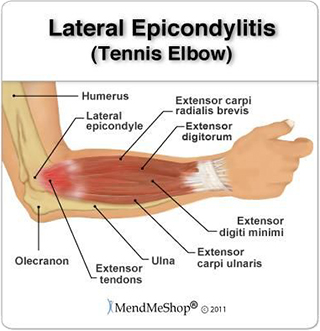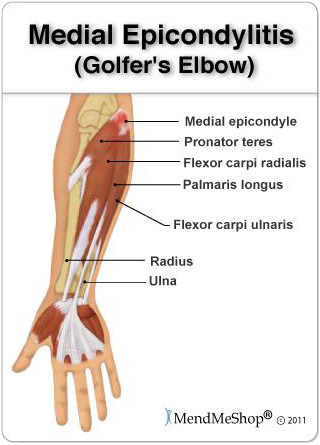
The elbow is formed by the elbow joint between the humerus and the ulna and radius. The elbow joint consists of three joints – the humerus-radius joint, humerus-ulna joint and the upper radius-ulna joint. Due to its bony anatomical structure, the elbow joint is quite sturdy.
An extension and flexion movement takes place in the elbow joint, and also rotational movement of the hand (pronation and supination).
The most common elbow disorders are types of epicondylitis. The epicondylitis is quite a common disorder because tendon sheaths and tendon attachments are prone to overload. The typical pain symptom inside the elbow is called golfer’s elbow and the pain symptom outside the elbow joint is called tennis elbow.
Elbow injuries usually result from an accident (work, traffic, falls, sports). Clamping of nerves can also cause pain in the area.
The cause of epicondylitis is overuse - similarly recurring movements, work tasks where a lot of hand force must be used; positions where the wrist must be bent. The cold and vibration also play a role in the onset of the disorder.
Smoking increases the risk of epicondylitis.
Tennis elbow:

It is generally believed that tennis elbow arises from racket games such as tennis; however, it can result from any overuse. It is one of the most common work-related strain injuries. Handling of heavy loads and tools, squeezing and rotating movements are risk factors for tennis elbow. Prolonged static tension in the extensor muscles of the wrist and fingers may also cause provocation of tennis elbow (including terminal work and mouse use).
Golfer’s elbow:
Golfer’s elbow is a similar disorder to tennis elbow. The symptoms only appear on the inner edge of the elbow, while in tennis elbow they localise on the outer edge.
Prolonged tennis or golf elbow is a difficult disorder, so it is worth applying for treatment in time.
Treatment
When beginning the treatment of tennis or golf elbow, it is important to avoid the load that caused the disorder for 1-2 weeks. Topically applied NSAIDs and oral NSAIDs are helpful in relieving pain. Rehabilitation begins when the acute pain in the wrist and elbow is relieved. Rehabilitation is focused on the muscles and tendons of the forearm.
Massage relaxes tense muscles. Cryotherapy relieves pain and eliminates inflammation in the acute phase. Heat-therapy adds blood circulation. Active exercises with a resistive band or Flexbar are effective. Acupuncture is also worth a try.
Various functional splints and supports may relieve pain and reduce strain on muscles and tendons. Today, electrical shock wave therapy is also used to treat tennis or golf elbow. By improving ergonomics, the workload can be relieved and the recurrence of disorders avoided.
It is important to start rehabilitation as soon as possible. The longer pain and other symptoms have been, the slower it heals.
